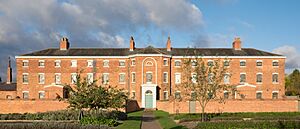The Workhouse, Southwell facts for kids
The Workhouse, also known as Greet House, is a special museum in Southwell, England. It is run by the National Trust and first opened its doors to visitors in 2002. This building was very important because it was built in 1824 and became a model for many other workhouses across the country.
Workhouses were places where poor people could live and work in the 1800s. The Workhouse in Southwell was considered the best example of its kind. It helped shape new laws about poverty in 1834, which led to many more workhouses being built.
Contents
Designing the Workhouse
The Workhouse was designed by William Adams Nicholson, an architect from Southwell. He worked with Reverend John T. Becher. Reverend Becher was a leader in making workhouses and prisons better. He believed in giving people daily tasks, like breaking stones or recycling old rope fibres called oakum, to help them learn discipline. The National Trust says this Workhouse is the best-preserved one in England.
From Home to Museum
The building was used as a workhouse for many years. Later, it became a place for mothers and children to stay temporarily, right up until the early 1990s. The National Trust bought the building because they wanted to protect its history. They also wanted to save this important building, which is a Grade II* listed building, from possibly being turned into regular homes.
Bringing History Back to Life
Restoration work on The Workhouse began in 2000 with repairs to the roof. This work has continued over the years to make the building look as it did in the 1800s. Many rooms have been decorated to show how they would have appeared back then. Some parts of the building, like walls and outdoor toilets, which had been taken down in the 1900s, have been rebuilt.
In March 2012, a newly restored laundry drying room was opened. This event also celebrated the long service of staff and volunteers.
A Place for Learning
The Workhouse is also a great place for students to learn. In 2013, it received the Sandford Award for Heritage Education. This award recognized it as an excellent learning facility for local schoolchildren. The property was also featured in a TV show called 24 Hours in the Past in 2015.
See also
- Grade II* listed buildings in Nottinghamshire
- Listed buildings in Upton, Newark and Sherwood


